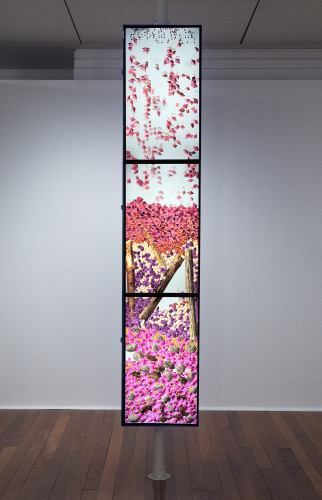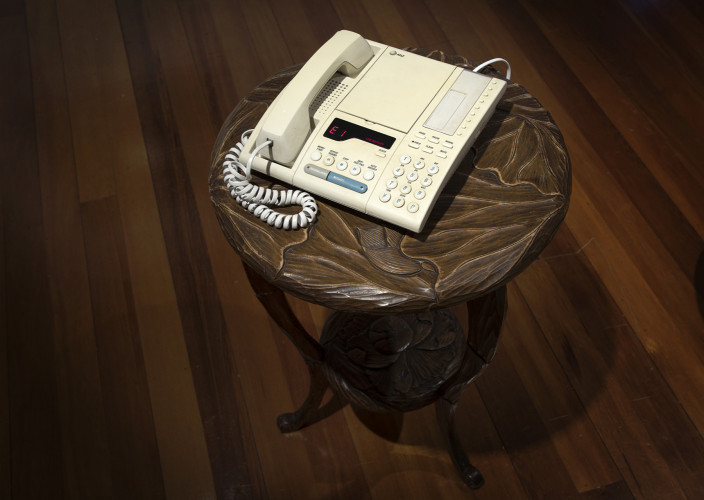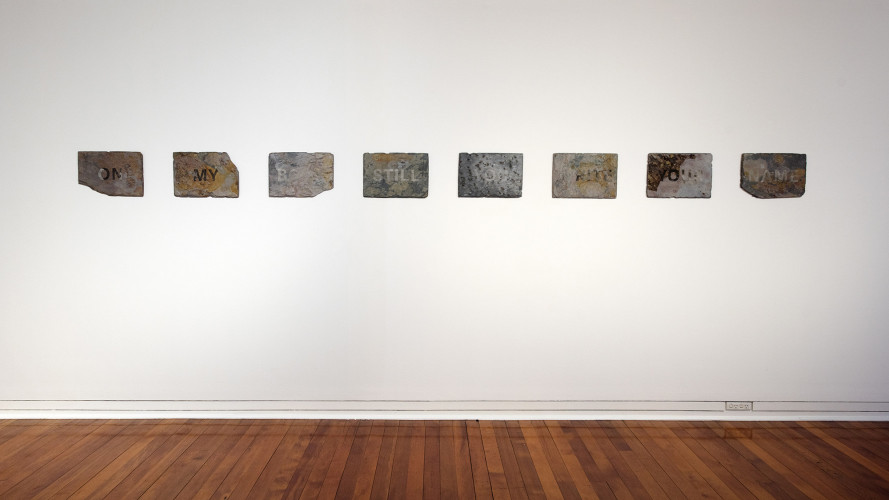Nature danger revenge
Alexis Hunter, Evangeline Riddiford Graham, Deborah Rundle and Sorawit Songsataya
2 July 2022 - 6 November 2022
Nature danger revenge is an exhibition of paintings by Alexis Hunter (1948-2014) which stem from a feminist and environmental consciousness of the 1980s, accompanied by new commissions from artists Evangeline Riddiford Graham, Deborah Rundle and Sorawit Songsataya. The exhibition takes Hunter’s paintings of hybrid creatures and environments—and their charged, even apocalyptic, language of expression—as heady ground to explore new horizons. Emerging from Hunter’s thick, churning brushwork is a tangle with normative understandings of nature, bodies and desires.
Born in Aotearoa New Zealand, Hunter spent much of her career in London. From the mid-1970s, she became internationally recognised for her photo-narratives that appropriated the language of commercial film and advertising to challenge gender and power relations. In the 1980s, she moved away from photography towards neo-expressionist painting. This remained Hunter’s primary artistic medium for the rest of her working life. In this exhibition, Graham, Rundle and Songsataya consider the agencies between expression and environment in dialogue with Hunter’s works that follow this shift in medium.
Graham explores a ‘whiplash’ between linear historical narratives and the pluralities of lived experience in Mother juggernaut (2022). Set within a strange living room tableau, this audio installation pushes at the boundaries of familiar exchanges, exploring the tension inherent between generations and cultural legacies. The artist has composed a script, based on the poetic structure of a double sestina, that plays through an answerphone machine. In this ‘voice message’, a needy millennial daughter frets about her life and job at a dystopian wastewater treatment plant. The monologue samples from the poetry of Michael Field—the joint pseudonym of Katherine Bradley and Edith Cooper, who wrote under a male pen name to establish themselves within Western literature’s Decadent Movement of the late 19th century.
Sculptural works by Rundle play with the metamorphoses of language and environment. My Body (2022), text etched onto slate tiles, leverages its materials to consider inscriptions of power. Rundle is interested in the ‘fugitive nature’ of this text, whereby environment and sightline affect its legibility. Technologies of learning and identity formation are also brought into focus. The work references resource extraction, writing tablets used in schools from the 1700s-1920s and the ground-breaking aspirations of feminist artist Mary Kelly’s Post-Partum Document (1973-79). Alongside this work, Loss (2021), a photo of a skink the artist found living among artificial grass, ruminates on vulnerability and survival. Skinks are known for their ability to ‘drop’ their tails to distract predators and regenerate a new one, but there is a compromise; the new tail is never quite the same as the original.
Songsataya’s Crown Shyness (2022) maps the outer bark surfaces of Aotearoa’s tallest tree—an Australian Mountain Ash Eucalyptus regnans (Purukamu) planted around 1870 in Orokonui Ecosanctuary, Waitati, north of Ōtepoti. Utilising a photogrammetric processing technique, Songsataya has converted video footage of the tree’s trunk into a set of ‘point cloud’ data. The artist has used this data to translate geospatial information into a new, textured landscape. Played across stacked vertical screens, the animation shows the digital ‘skin’ of the trunk, composed of small polygons, stretching upwards. In another sequence, cascading 3D particles illustrate the law of gravity. Exploring these parameters—in and above the ground—that the tree lives within, Crown Shyness employs digital technology to reimage the tree as an intelligent, vital being in constant negotiation with their ever-changing environment.
Bringing these practices together around Hunter’s work, this exhibition questions what kind of subjects we are becoming in our current climate, and what might come next; what kinds of reeling, transformation and life?
_____
He whakaaturaka peita nā Alexis Hunter (1948-2014) a Taiao mōrea utu i puta mai i tētahi tūoho whakakōkiri mana wahine me te taiao i te kahurutau 1980, ā, ka puta tahi me ētahi mahi toi hou ko whakakirimanahia nā Evangeline Riddiford Graham, rātou ko Deborah Rundle, ko Sorawit Songsataya. Ko tā te whakaaturaka ka kawea te reo hihiko, te reo pōautinitini – hai tūāpapa taunanawe kia haea ai kā paeraki hou. E puta atu ana i te mahika taumaha, i te mahika kōrori o tā Hunter paraehe he whakawhiwhika ki kā māramataka māori o te taiao, o kā tinana, me kā koroiko.
I whānau mai i Aotearoa, ekari he roa tou tana noho ki Rānana. Mai i te waeka o te kahurutau 1970, i rokonui ia ki te ao i āhana pakiwaitara-whakaahua i kōhakina te reo o kā kiriata me kā whakatairaka kia wero atu ai i kā honoka ā-ira, i kā honoka mana. I kā kahurutau 1980 i huri tuarā ia ki te mahi whakaahua, ā, i aro kē atu ia ki te mahi toi pūkare. I mau kaha a Hunter ki tēnei momo mahi toi tae noa atu ki tōhona mateka. I tēnei whakaaturaka, ka āta whakaarohia e Graham, e Rundle, e Songsataya hoki te mana me te wānaka ki waeka i te pūkare me te taiao ki kā mahi toi o Hunter e whai ana ai i tana nuku ki tēnei momo kaupapa toi.
Ka whakatōmenetia e Graham he ‘tā kōheri’ i waeka i te pūrākau tāhuhu tōtika me kā wheako oraka matatini ki Te Whaea Matatū (2022). Ka tū ki roto i tētahi whakatauirataka rūma noho rerekē, ka peia atu te whakaaturaka oro nei ki kā roheka whakawhitika kōrero umaka, ka hōparahia te mānukanuka i waeka i kā whakatupuraka me kā tukuka ihotaka. Ko titoa e te rika toi tētahi pakiwaitara, i ahu mai i te aka toi-kupu, whakarua-ripa-ono, ā, ka whakatakihia ki te pūrere whakautu waea. I tēnei ‘karere reo’, e anipā ana te tamāhine takitaki o te reaka manotau mō tōhona ao, mō tōhona mahi ki tētahi tohetū whakanao wai-para-takata ao houmate. Ka tīpakohia te whaikī tōtahi nei i te momo toi-kupu o Michael Field – Koia te ikoa tā ka whakamarumaruhia a Katherine Bradley rāua ko Edith Cooper, i tuhia ki taua ikoa tāne kia whai wāhi ai rāua ki te Kaupapa Tauheke Mātātuhi o te Tūāpori o te Rātō i te otika o te rautau 1800.
Ko kā mahi whakairo a Rundle ka rāweke i te kāhuarau o te reo me te taiao. Mā te kupu ko whakairohia ki kā papauku mākoha, ka huaka a Tōhoku Tinana (2022) i ōhona papaka kia whakaarohia he whakairo whai mana. E manawa whakapuke ana a Rundle i te ‘āhua taurewa’ o ēnei kupu, mā reira te taiao me te tirohaka e whakaawe ana i tōhona māramataka. Ka kakahu mai kā hakarau ako, me kā hakarau whakapakari tuakiri. Ka whakatohutorohia te kerika o kā rawa, kā mākoha tuhituhi i whakamahia ki kā kura mai i kā rautau 1700 ki te te kahurutau 1920 me kā wawata ahurei o te mahi toi o te rika-toi kaikōkiri mana wahine Mary Kelly, Te Tuhika Mō Muri i te Whānautaka Mai (1973-79). Hai hoa ki tēnei mahi, Ko Karo (2021), he whakaahua o te mokomoko i kitea ai e te rika-toi i te noho ki te pātiti tāwhai e whakaaroarotia ana ōhona whakaraerae me tōhona oraka toutaka. Rokonui ana te mokomoko i tā rātou āheika ki te ‘whakataka’ i ō rātou whiore hai whakapōrearea i te konihi, ā, ka whakatupu i tētahi whiore hou, ekari he utu. He rerekē te whiore hou, kāore i pērā te pai o te mea tika.
Ko Te Whakamā o te Karauna (2022) nā Songsataya ka whakamahere i te hiako o te rākau teitei rawa atu ki Aotearoa ko te Australian Mountain Ash Eucalyptus regnans, arā ko te Purukamu i whakatōhia ai i te takiwa o te tau 1870 ki te Whakamaruka Taiao ki Orokonui, Waitētē kai te raki o Ōtepoti. I whakamahia he tikaka tuhi mahere nā te whakaahua e Songsataya ki te whakatakahuri i te haoka kiriata o te tinana o te rākau ki tetahi huika o te rarauka ‘kapua kātara’. Ko whakamahia ēnei rarauka ki te whakamāori i te pāroko mātai matawhenua ki tētahi horanuku kaitara. E whakaata mai ana i ētahi mata whakaata poutū ko whakapaparia, ko te pakiwaituhi ka whakaatu i te ‘kiri’ matihiko o te kahiwi, ko hakaia e kā taparau iti, e toro whakaruka ake. I tētahi atu raupapa, ko kā korakora ahutoru e horo mai ana hai whakaatu i te ture tō ā-papa. Ko te āta titiro atu ki ēnei roheroheka – ki roto, ā, ki ruka hoki i te whenua – e noho ana te rākau, ko Te Whakamā o te Karauna ka whakamahia te hakarau matihiko ki te whakahou i te whakaahua o te rākau hai kaiora mātau, hai kaiora waiwai e whakawhitiwhiti kōrero tou ana ki tōhona taiao hurihuri.
Mā te whakakotahi o ēnei mahi ki te taha o te mahi a Hunter, e ui atu tēnei whakaaturaka ki tā mātau huri hai aha i tēnei āhua o te ao? Ā, ka aha ka whai nei? Ko ēhea momo ānininini, ko ēhea momo panonihaka, ā, ko tēhea momo oraka?
View the exhibition labels – click here















